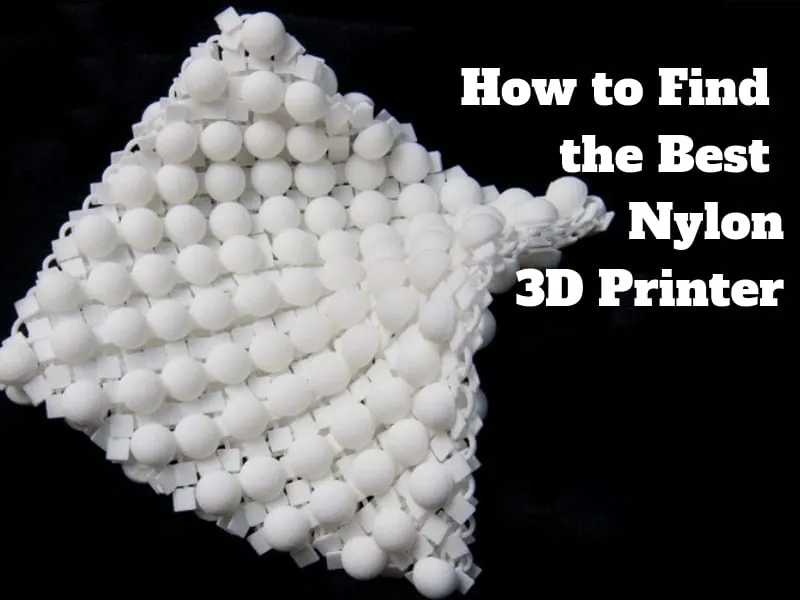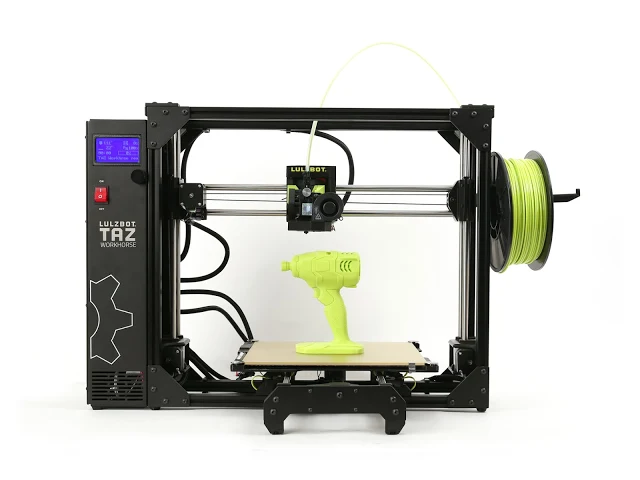- How to Remove 3D Print From Bed - May 31, 2022
- Autocad vs Inventor: Which Software is The Best? - April 5, 2022
- Autocad vs Revit [2022]: Which Is The Right Choice? - March 31, 2022
Nylon is designed to give you a next-level experience with 3D printing. As a printing material, it’s just as versatile as more common filaments like PLS or ABS, but it has the added advantages of flexibility, tensile strength, and extraordinarily high layer resolution.
Its low friction coefficient and high melting temperature (and melting point) make it great for parts that have to move against each other without breaking like gears; other types of filaments are too brittle for the kind of wear and tear inner workings often exhibit.
Nylon is also called Polyamide, which means it’s a synthetic polymer that is made by linking an amino group of one molecule with the carboxylic molecule of another. That makes nylon plastic with super long, heavy molecules built from short but endlessly repeating sections of atoms. Think of chains made out of lots of individual links to get the idea.
Nylon’s structure is what gives its strength to any 3D filament made from it, and it also gives nylon filament material the stretchability that makes it so easy to spin into a filament in the first place. It’s got a lot of usage beyond industrial parts, too – anything you need to print with strong flexibility is a great choice for nylon 3D filaments.
The Pulse XE is designed specifically for nylon 3D printing and will hold up well with repeated use as such. Minimal learning curve here AND it's generally more affordable than competitors with nylon print capability.
Unfortunately, you can’t just switch out your current filament with nylon material and start printing without a few key considerations. But after you read these recommendations, you’ll be ready to either adjust your own flexible 3D printing rig or find a whole new one that’s more than up to the task.
Table of Contents
What Are Some Good Nylon 3D Printers?
These are the best nylon 3D printers we’ve tested:
- Pulse XE NylonX Printer is built precisely for heavy-duty nylon printing and one of the ONLY 3D printers with this “nylon first” approach (although it works with many other materials as well – it’s just optimally pre-assembled for nylon). Our PickOur Favorite 3D Printer for Nylon? | Matter HackersCheck Price
The Pulse XE is designed specifically for nylon 3D printing and will hold up well with repeated use as such. Minimal learning curve here AND it's generally more affordable than competitors with nylon print capability.
We earn a commission if you click this link and make a purchase at no additional cost to you. - LulzBot Taz Workhorse is perhaps the best suited to nylon printing as it has a flexible design, large print volume, and widely compatible with all kinds of filaments (including the Taulman nylon filament or Taulman Bridge Nylon specifically). LulzBot TAZ Workhorse 3D Printer | Matter HackersCheck Price
With the TAZ Workhorse Edition, they've developed a 3D printer that's inviting to hobbyists while also as tough as a manufacturing beast.
We earn a commission if you click this link and make a purchase at no additional cost to you. - QIDI TECH 3D Printer is a great option that SPECIFICALLY lists nylon as a supported printing material (printer filament).
- Ultimaker S5 is a phenomenal – best in class – 3D printer overall, but it also works with nylon filament out of the box! Ultimaker S5 Dual Extrusion Large-Format 3D Printer | Matter HackersCheck Price Buy at Amazon.com
This versatile 3D printer is ideal for higher volume printers, looking for capacity, reliability, and dental customization.
We earn a commission if you click this link and make a purchase at no additional cost to you. - Dremel Digilab 3D40 Flex Printer is a great option for an all-enclosed printer, with a flexible build plate, 50 microne ultra-high resolution, and also compatible with their own custom Dremel nylon filament.
Nylon 3D Printer Pros and Cons
Pros of Working with Nylon
Strength and Flexibility
These are the traits you will hear touted over and over again when you work with nylon, and there are plenty of good reasons for this. Most notably, you’ll get around the inherent brittleness found in a lot of other common thermoplastics that stop them from being truly useful replacements for machine parts that experience a lot of grinding. Parts printed with nylon filaments don’t have that issue.
The thinner nylon is stretched, the better it can show off its strength, which it exhibits so easily from the fact that its molecular structure lets it bend under pressure. These traits let you experiment with animating 3D printing objects that you may have previously used only for show.
High Layer Resolution
Most people think of layer resolution as the amount of material used for each layer and how detailed that can make your final object. But that aspect of resolution is only half the story. It’s important to look at all the axes – X, Y, and Z – to calculate the true level of detail you’ll be able to get, and nylon is a star on all sides.
Its flexibility lends its the ability to produce thinner layers of print, which lets you get extremely detailed, and depending on your nozzle size, its precise melting temperature makes it stick to itself like Spiderman’s web holding a bus together. Plus, it won’t shrink down as much as more brittle materials like the more common PLA or ABS.
Resistance to Impact
Nylon’s strength is truly in its flexibility. Since the material has given, it rolls with the punches, which for 3D printed objects translates to not shattering into a million pieces you spent hours putting together in the first place when it’s dropped. And this is great for more than an insurance against clumsy hands and shaky shelves. If you’re looking to print an object that you want to put through the wringer, nylon’s the perfect material.
One fun project to test this is to print an egg cradle, like old school physics classes used to show the impact of gravity. If you’re into pitting things against each other, print one from PLA, one from ABS, and one from nylon, and see which one keeps the egg nice and cozy. (Hint: it’ll be the nylon!)
No Unpleasant Odor
Most thermoplastic filaments give off a distinctive and, let’s be honest, gross smell when they’re being used in a 3D printer. Not that we blame them; plastic is going to stink however you decide to melt it. But if you’re resigned to it as just an unfortunate quirk of the 3D printing process, you need to try printing with nylon. At its optimal bed temperature, it doesn’t give off any odor.
If this sounds like a trivial issue to you, try it once, and see how much more pleasant your experience is. And this is key to working well in either an enclosed area where you don’t have ventilation technology or a shared area where more than one person will be 3D printing or where multiple machines will be in constant use (like a fabrication shop).
Resistance to Continuous Abrasion (Abrasion Resistance)
Of course, this is good news for more than your eggs. Nylon’s refusal to get chipped or worn down from repeated beatings makes it a favorite for internal industrial machine work like gears.
Its resilience and print quality makes it perfect for parts that you can’t afford to replace regularly, especially if that’s because the parts are going to be grinding against each other or another abrasive surface for hours at a time multiple times a week.
Thanks to nylon’s affordable availability, this applies just as much to the desktop operation of your favorite movable action figures as it does to your pro level machine shop, so it’s a great material to invest in for your rugged 3D printing needs.
The Pulse XE is designed specifically for nylon 3D printing and will hold up well with repeated use as such. Minimal learning curve here AND it's generally more affordable than competitors with nylon print capability.
Availability and Cost
With all these specialized perks, nylon sounds like it’d be an expensive, difficult printer filament to find. But it’s not – it’s just a few bucks more per spool than more popular material, and your favorite source for PLA or ABS more than likely stocks nylon, too. It’s plentiful enough to experiment with and get to know, which is something you’ll be glad you did.
NOTE: You can check out the selection of nylon printer filament here on Amazon, or the specialty options here on MatterHackers.
Cons of Working with Nylon
Attracts Water Very Easily
Nylon attracts and absorbs moisture at a rate far greater than other 3D printing filaments. It can absorb up to 10% of its own weight in less than 24 hours; nylon is a polar structure, which means within its molecules, positive and negative charges are arranged asymmetrically.
This makes it easy for water molecules to latch onto them and absorb into the nylon’s structure, zapping it of its strength and making it unravel. This means that you have to do more than make sure you don’t use nylon to print flower vases or coffee mugs – you need a special storage system to make sure your unused printer filament doesn’t absorb any moisture from the air when you’re not using it, and you have to monitor the humidity of your work environment to make sure it stays optimal for working with this material.
If you print with nylon filament that isn’t dry, the water it retains explodes within the printer filament, causing air bubbles that will ruin the layer adhesion and surface finish. You can make sure your nylon filament is dry by heating your oven to 160 – 180 degrees Fahrenheit (70 – 82 degrees Celsius) and “baking” the nylon for 6 – 8 hours.
Otherwise, you need to keep it in an air-tight container and make sure it stays in a dry storage environment. The desiccant is another handy tool you can use. It’s those packets of small beads labeled “do not eat” you find in new purses, shoes, or other goods that don’t need to attract moisture, and you can buy them with a simple internet search.
NOTE: We picked up some premium air-tight containers to maintain our print quality at this listing with MatterHackers.
Warping
Because of nylon’s flexibility, its structure is more prone to warping than filaments with less give. You need to keep a close eye out on the adhesion your filament makes with your heated bed, especially if you are not working with a specialized gripper surface.
Applying a PVA-based adhesive to your printing surface makes a world of difference, and if you’re worried that sounds too fancy for your budget or skill set, don’t be – it’s those same Elmer’s glue sticks you used all through school.
Laying down a solid base for the first layer’s adhesion builds a good foundation for the rest of the object. Plus, don’t use that parts cooling fan you rely on to speed up your object’s completion. If you use that on nylon, it will weaken the material’s bond and encourage warping in the overall shape.
Needs a Higher Head Temperature Than Most Built-In Nozzles Can Deliver
Nylon’s trickier manipulation quirks mean it needs a specific temperature range that standard 3D printers are not built to handle straight out of their boxes. Generally, it needs an extruder temperature of 240 – 260 degrees Celsius, depending on the specifics of the flexible filament brand.
Standard heater heads are made of PEEK (polyether ether ketone / polylactic acid) and PTFE (polytetrafluoroethylene), both of which start to break down and emit noxious fumes at the low end of the temperature range you need to print with nylon. Find yourself an all-metal extruder nozzle, and you should be good to go since those are able to heat up to high temperatures without any structural issues.
NOTE: Determining the right hot end is key here. We’ve had luck with retrofitting all kinds of 3D printers with the E3D V6 hot ends from MatterHackers here.
Needs to Fully Cool at Its Own Speed
As tempting as its ability to cut your finish time in half may be, don’t use that parts cooling fan you rely on to speed up your object’s completion. If you use that on nylon, it will force water and air bubbles into the layers of your print, and as we mentioned above, that will turn your filament into a mess of un-sticky noodles.
So let your nylon print cool away from any winds or drafts, intentionally made or otherwise, and you’ll preserve that buttery surface finish for which nylon is so coveted as a filament.
What to Look For in Your Gear
Don’t let nylon’s quirks keep you from enjoying its perks. If you’re worried about working with a tricky material, you can rest easy knowing that just a few simple, accessible adjustments can make your 3D printer work great with nylon.
- If you’re looking for the best and quickest adjustment, get a detachable all-metal extruder nozzle. They’re sold separately and cheaply, and after you’re done printing with nylon, you can go right back to your printer’s original head without more trouble than changing a light bulb. And heck, if you want to set up a nylon-exclusive printer, there are plenty out there that come with permanent metal-only extruders, so you don’t have to even think about your heater head’s temperature.
- Another easy fix that will make dramatic improvements to your nylon builds is making sure your heated bed is covered in the right surface. If you are using a glass print bed, make sure it can be heated. That is vital for the stability of your nylon print. Alternatively, you can use Garolite for your heated bed. It’s a linen-based phenolic sheet made by impregnating glass cloth with an epoxy resin under pressure and heat. You will need a build plate that can transfer heat to the Garolite build surface, but it’s worth it for the print bed adhesion you will get.
- You should also look for airtight containers that can store your nylon – some 3D printers have compartments built into the printer body itself, but check the seals before you decide those are enough. Those that aren’t specifically made for nylon may have air leakage issues, but airtight storage is good for several other types of durable filament material as well, so they are more common than you might think.
There are also 3D printers available built exclusively to print with nylon filament types. If you’re done testing the material and are ready to use nylon on an industrial scale for durable additive manufacturing, it may be worth investing in one of these bad boys, so you have all the settings and parts already adjusted as needed.
Conclusion: Top Nylon 3D Printers
Nylon is a great durable filament to work with. It’s got strength and flexibility beyond what you can find in the more popular PLAs and ABSs, and in spite of its tricky reputation, it’s not that much more difficult than working with either of those introductory materials.
You’ll fall in love with its layer resolution as well, which brings exquisite detail to your finished prints. You do have to keep several things in mind before you work with it, but once you’ve gotten those easy couple of pointers down, you’ll be ready to print with nylon in no time.
The Pulse XE is designed specifically for nylon 3D printing and will hold up well with repeated use as such. Minimal learning curve here AND it's generally more affordable than competitors with nylon print capability.
Recommended Reads
- How to Find the Best Wax 3D Printer
- How to Find the Best 3D Printer for Miniatures
- How to Find the Best 3D Printer for Titanium
- How to Find the Best Carbon Fiber 3D Printer
- Best 3D Printer for Jewelry
- Best Dental 3D Printers
- 3D Printing vs Injection Molding Compared
- CubePro Duo Review – My Take on the CubePro Duo 3D Printer
- Getting Started With 3D Printing – Steps for Learning How to 3D Print
- Creality CR 10 Review – Is It The Right Printer To Have?









